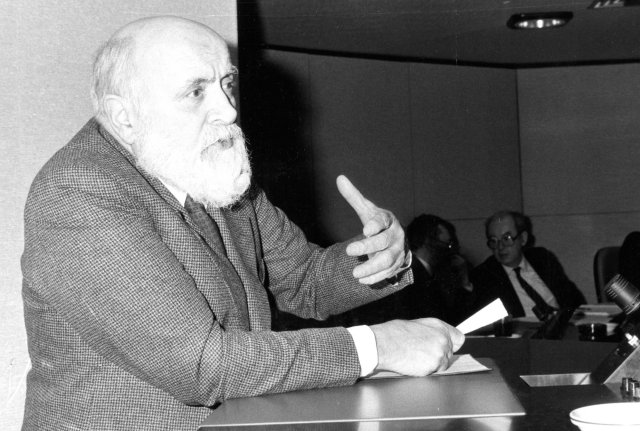Altiero Spinelli, one of the founding fathers of the European idea and author of the manifesto of Ventotens
Photo: Imago/Belgian
It will be happy to be part of the history of the European Union The Manifesto, which three Italian anti -fascists in 1941, in the middle of the war, had secretly written on prison island off the coast between Rome and Naples. At the height of the power of power of the dictatorships of Hitler and Mussolini, it called up to a fundamental Europe -wide socialist upheaval. In his radical billing with the social causes that led to the war, it was clear. The development of the nation states was historically a powerful moment to enforce democracy, even under capitalist conditions. However, their competition among themselves and the submission of society among increasingly totalitarian states led to the crisis and a Second World War, instigated by German militarism, the triumph of which must be prevented by all means. However, one victory of the Allies would not be enough alone, the social conditions that the dictatorships had made possible should not remain untouched. So the authors called for a fundamental upheaval that Europe had to unite and would eliminate the competition between the states. They added: “The revolution must, it should meet our needs, be socialist, that is, it must work for the emancipation of the working classes and for the creation of more human living conditions.” The manifesto resulted in a number of concrete, immediate democratic and social demands. To implement their implementation, the workers and intellectuals would have to work together.
The three authors stood for different currents and experiences of the Italian workers’ movement. Main author Altiero Spinelli, born in 1907, joined the Communist Party in 1924. After three years he arrived and passed through a wide variety of prisons before being banished to the island in 1939. Then he had already been excluded from the party because the Moscow had criticized show processes. Ernesto Rossi, born in 1897, had traveled an ambivalent political path. He was involved in the founding of the fascist party in Italy, but left it in front of Mussolini “March on Rome” and joined the sometimes liberal socialist group Giustizia e Libertà (justice and freedom), in which Republican and anti -fascist intellectual gathered. He was arrested in 1930 as one of her leaders.
The third in the round, Ernesto Colorni, represented the socialist current. As a contact man between the party leadership in exile and the comrades in Italy acting in Italy, he was targeted by the fascist secret police in 1938. In addition, he came from a Jewish family and were also gradually introduced to anti -Semitic laws in Italy. Incidentally, he was married to Ursula Hirschmann, the sister of an activist of the left -social democratic resistance group, who was later a well -known, often across the economic orthodoxy of economic experts in the USA under his Americanized name Albert Hirschman.
The manifesto was written on cigarette paper by its three authors and the wives of Rossi and Colorni smuggled out onto the Ventote after visiting their men from the detention center. Individual passages soon circulated in the illegal press of the resistence, the Italian resistance movement. But it was only after the fall of Mussolini in July 1943, which also led to the release of the three authors, did their vision experience a wider echo, even if the liberation of Italy dragged on for two years.
With its entanglement of basic democratic demands with a socialist orientation as a settlement with fascism and Nazism, the manifesto of ventotene met social awareness at the moment of falling the dictatorships in Europe. The causes of the disaster of the war were seen in the capitalist social order and the shameful behavior of their elites. Even in the so -called Ahlen program of the CDU of 1947, the demand for a “community order” appeared, since capitalism no longer lives up to the situation.
Socialist ideas had mobilized and motivated a wide variety of resistance movements in Europe. After the exemption in many countries, they took over, albeit only for a short time, the power in the form of liberation or anti-fascist committees and were partly involved in the initial post-war governments. But this “moment of liberation”, as the German historian Gerd-Rainer Horn, who teaches in Paris, recently quickly evaporated in a comprehensive study that has not yet been transferred to German. Stefan Heym’s book about the small town of Schwarzenberg in the Ore Mountains, which was temporarily unoccupied at the end of the war in 1945, gives an idea of the hopeful mood of optimism despite the geographically extremely small dimension, which, however, dried up in summer 1945. Not least because the Allies had agreed on a compromise in the conferences of Jalta and Potsdam to not question the overall social balance internationally to the demonstration. The cold war threw its shadows ahead.
This was not without consequences for the manifesto of ventoted people. The first post -war publications defuse its anti -capitalist dimension, the tenor was entirely on the creation of a European federal state, the question of its social constitution took a back seat. Spinelli in particular focused on this as part of the various European institutions, while Rossi worked as a journalist in Italy. Tragically, Colorni died in the last fights before Rome was liberated in May 1944.
Ultimately, it is not surprising that the manifesto has become a kind of mere catchphrase today without mentioning its original content. This also explains that it was cited by the newly elected President of the European Commission, Ursula von der Leyen, not exactly known as an anti -capitalist, to justify the policy she became.
Reiner Tosstorff is an unscheduled professor of the latest and contemporary history at the Johannes Gutenberg University Mainz.
judi bola judi bola online judi bola link sbobet
